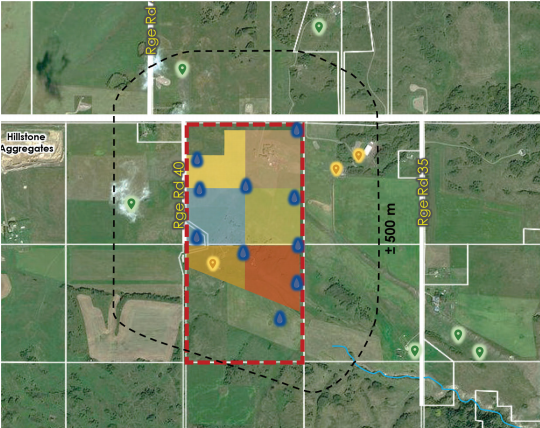Local groups are vowing to continue to fight against a contentious gravel pit application west of Airdrie that was given the go-ahead by Rocky View County (RVC) council on March 2.
The application, made by Mountain Ash LP, will see a more than 320-acre gravel pit established in a quarry located approximately 300 metres away from Big Hill Spring’s creek underground headwaters, and 1,200 metres from the park’s boundary.
Gerry Bietz, the president of the Bighill Creek Preservation Society, said they were disappointed by RVC council’s decision to approve the project, given the public opposition it received.
“We were obviously very disappointed in the outcome and saddened by the process,” he said. “We believe that we had put together a strong scientific case that this application should be denied. There were a vast preponderance of letters and submissions of opposition, including from Parks, to the application.”
The Bighill Creek Preservation Society is responsible for the stewardship of roughly 40 acres of land surrounding Bighill Creek – the aquifer directly downstream from Big Hill Springs Provincial Park.
Bighill Creek is a fish-bearing body of water that has been identified as critical spawning ground for bull trout, a threatened species according to the Species at Risk Act.
At the public hearing on March 2, RVC received 31 audio and video messages pertaining to the gravel pit application, all of which were in opposition. Additionally, a number of letters were received in opposition.
One such letter from Alberta Environment and Parks, which requested council to delay the decision, asked for a more thorough environmental review.
“As the Big Hill Springs are so closely linked to the groundwater at the Mountain Ash site, we question the proposal’s potential impact on groundwater quality and spring chemistry, effects on tufa formation, and its effects on fish and fish habitat,” the letter from Parks stated.
One of the strongest items of opposition was a 57-page report compiled by hydrologist and geologist, Dr. John Fennell.
Fennell has been a practising consultant in the natural resource sector for more 30 years, during which he has gained experience in contaminated sites assessment, development of local and regional-scale groundwater systems, mine de-watering strategies, water supply and disposal, groundwater-surface water interaction assessment, implementation of monitoring and management systems, climate analysis and adaptation strategies and environmental forensics, according to his report.
Fennell’s report indicated Big Hill Springs, and the underground aquifers that feed it face a high degree of risk by the development, contrary to the findings of Mountain Ash LP’s own groundwater study.
“There are definite future ramifications for this type of development when considering local groundwater users and surface water bodies that receive, and rely on, the groundwater discharging from this sand and gravel aquifer,” the report stated. “Not only is there an issue regarding changes to groundwater quality, but there is also legal liability associated with future impacts to aquatic habitat and fish in Bighill Creek, which could trigger a series of violations related to provincial and federal [legislation].”
The operation not only threatens the groundwater quality in the Bighill Spring Provincial Park, according to Fennell’s report, but the habitat-supporting aquifers that exist downstream from it.
“Big Hill Springs is a spring complex fed by the very same groundwater residing in the sand and gravel deposit that [Mountain Ash LP] intends to mine for aggregate resource,” he stated. “The relatively stable (and cool) temperature of the spring water (around 6°C), and its high quality (low mineralization and turbidity), has led to the development of local habitat that supports various vegetation, wildlife and aquatic species.
“As such, the Big Hill Springs, the established Park area, and the associated ecology are an important aspect of Bighill Creek’s ability to sustain ecological viability.”
Fennell’s recommendation was not to halt gravel mining in the area completely, but rather provide a 1.6-kilometre easement from the boundary of the park, as well as the preservation of a three-metre thick layer of gravel filtration for the next 800 metres beyond that.
Bietz said that there are several other quarter sections of land that directly border Big Hill Springs Provincial Park, and this decision sets a precedent that will allow for the approval of other projects near the park.
The worst-case scenario would be to remove the natural organic filtration that provides the spring with such high-quality water, Bietz said.
“That’s the concern,” he said. “You’re removing between 10 and 25 metres of existing gravel that operates as a filter. After all of these pits are eventually developed, then it creates a huge basin which will collect water and force water down through that limited filtration, directly into the spring. Once you’ve removed the filter, you can’t put the filter back.”
Given the opposition the project received from RVC residents, environmental groups, Alberta Environment and Parks and at least one experienced hydrologist, Bietz said the Bighill Creek Preservation Society is going to continue to fight against the application.
“We are working on what other strategies there are to encourage politicians to become involved in this conversation, because it seems like it’s going to require some input from regulatory as well as political spheres in order to have this application delayed, or set aside or re-evaluated,” Bietz said. “Obviously, public pressure is one of the levers that can be brought to bear on politicians.”
Beitz said that he wants to encourage concerned residents to reach out to environment minister Jason Nixon, or Airdrie-Cochrane MLA Peter Guthrie to try and bring attention to the decision.
What is at stake due to the development, Bietz said, apart from the potential damage to the aquifer itself, is “hard to quantify.”
“A park experience is supposed to be a tranquil environment surrounded by nature, and having an industrial site on the doorstep of the park doesn’t seem to be compatible with that kind of environment,” he said.
RVC was contacted for comment but declined to provide a statement to Great West Media.



